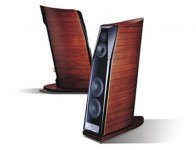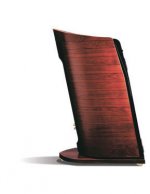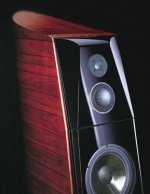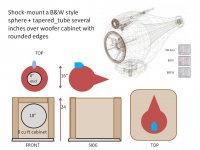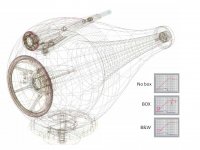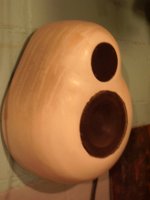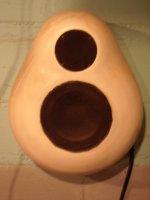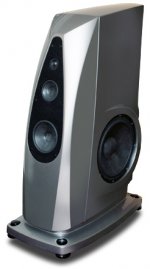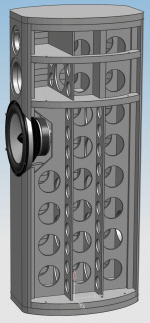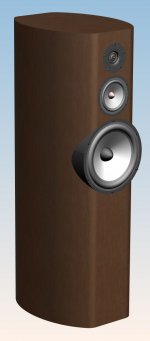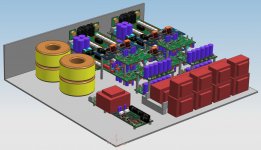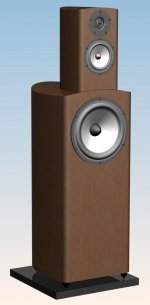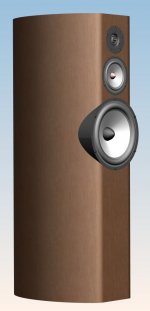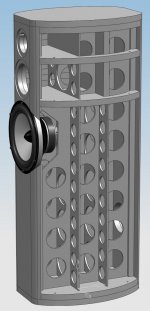😛possible exception is that first white one, that looks like Beaker from the Muppets
I have no problem with someone sticking with a square cabinet and believing it will sound nearly as good as an exotic cabinet. What I object to is a manufacturer selling a very expensive, very elaborate cabinet shape, claiming high performance, when it is clear that the shape is suboptimal in terms of diffraction effects.
If people want to spend a lot of money on exotic drivers then it would be a shame to have that performance degraded by a bad cabinet. How many times have you heard: "I don't (or do) like the sound of such-and-such tweeter" when the sound of any tweeter is strongly dependent on the mounting surfaces, edges, grilles, etc.
As always, good design means finding a way to have great cosmetics and highest performance at the same time.
David S.
John, I have to disagree. Which of these speakers do you think disappears better, less fatiguing, and more revealing?
A)

B)

Which do you think I use in my HT and which do you think are uglier by popular opinion?
I'd go for better sounding speakers any day.
Dan
A)

B)

Which do you think I use in my HT and which do you think are uglier by popular opinion?
I'd go for better sounding speakers any day.
Dan
Hi novec,
The USHER BE-20 or BE-10 may give you additional ideas for your DIY.
-truncated pyramid for diffraction control
-slanted baffle for time alighment
-rounded sides-rear for diffraction and resonance control
www.usheraudio.com/news/TAS-BE-20_eprint.pdf
Description
Usher Audio speakers and electronics are built for the experienced listener who won't compromise on sound quality even at moderate prices. The exquisite Be-20 features 5-inch inverted-dome midrange drivers in addition to our unparalleled 1.25-inch Diamond DMD tweeters. Two 11-inch Eton Kevlar woofers power the bass, and time-aligned cabinets ensure any high-quality tubed or solid-state amplifier sounds its best. The integration, speed and clarity of these drivers uncover low-level detail usually lost in the noise floor of less resolving speakers. Dr. Joseph D'Appolito is our technical consultant providing guidance on crossover design, resulting in suave, powerful, transparent and engaging sound from beautifully crafted and lustrously finished cabinets made with leading-edge components at very affordable real-world prices.
Suggested Retail Price
$21,199 /pr
3-way system Be dome tweeter 1.25" (9980-20BeK), mid-low woofer 5" (0541A) and low-bass woofer 11"x2 (ETON 11-584)
Sensitivity 90 dB @ 1 watt / 1m
Nominal impedance 8 ohms
Frequency response (-3 dB) 22 Hz ~ 40 kHz
Power handling 200 watts
Crossover frequencies 544 Hz and 3.84 kHz
Weight 293 lbs (including base)
Dimensions (w x d x h) 14.4" x 35.2" x 55.1"
Shipping weight 304 lbs /pc (including wood crate without base), 41 lbs /pc (base)
Shipping box (w x d x h) 21.7" x 35.8" x 63.0" (including wood crate without base), 17.7" x 37.8" x 7.5" (shipping base)
The USHER BE-20 or BE-10 may give you additional ideas for your DIY.
-truncated pyramid for diffraction control
-slanted baffle for time alighment
-rounded sides-rear for diffraction and resonance control
www.usheraudio.com/news/TAS-BE-20_eprint.pdf
Description
Usher Audio speakers and electronics are built for the experienced listener who won't compromise on sound quality even at moderate prices. The exquisite Be-20 features 5-inch inverted-dome midrange drivers in addition to our unparalleled 1.25-inch Diamond DMD tweeters. Two 11-inch Eton Kevlar woofers power the bass, and time-aligned cabinets ensure any high-quality tubed or solid-state amplifier sounds its best. The integration, speed and clarity of these drivers uncover low-level detail usually lost in the noise floor of less resolving speakers. Dr. Joseph D'Appolito is our technical consultant providing guidance on crossover design, resulting in suave, powerful, transparent and engaging sound from beautifully crafted and lustrously finished cabinets made with leading-edge components at very affordable real-world prices.
Suggested Retail Price
$21,199 /pr
3-way system Be dome tweeter 1.25" (9980-20BeK), mid-low woofer 5" (0541A) and low-bass woofer 11"x2 (ETON 11-584)
Sensitivity 90 dB @ 1 watt / 1m
Nominal impedance 8 ohms
Frequency response (-3 dB) 22 Hz ~ 40 kHz
Power handling 200 watts
Crossover frequencies 544 Hz and 3.84 kHz
Weight 293 lbs (including base)
Dimensions (w x d x h) 14.4" x 35.2" x 55.1"
Shipping weight 304 lbs /pc (including wood crate without base), 41 lbs /pc (base)
Shipping box (w x d x h) 21.7" x 35.8" x 63.0" (including wood crate without base), 17.7" x 37.8" x 7.5" (shipping base)
Attachments
John, I have to disagree. Which of these speakers do you think disappears better, less fatiguing, and more revealing?
Which do you think I use in my HT and which do you think are uglier by popular opinion?
I'd go for better sounding speakers any day.
Well, first I don't experience listener fatigue. That is due to the fact that I love music and I listen to it, rather than the speaker or the drivers or the baffle or the room, etc. When I'm listening to music, I prefer to have good sound but I can do without it. Not the end of the world. That isn't to say that my speakers sound bad - they don't.
Your measurement data shows a marginal difference that may or may not be audible. Left out was your testing procedure and how you made the 'improvement'. It's good to remember this: just because it can be measured, doesn't always mean we can hear it. The opposite of this axiom is often used around here but is quite a bit less reliable.
Without hi-jacking novec's quest, but staying on the cabinet diffraction topic.
I've been waiting for the AESpeakers Lambda 8M midbass and thinking about Olson's sphere diffraction models along with B&W's whitepapers on sphere + tapered tube for the Nautilus. A small dome like the SB29RDCN or RAAL 70 ribbon would get mounted on top.
Would shock mounting a sphere + tapered tube above a bass cabinet with rounded edges pass critical review in this diffraction discussion?
I've been waiting for the AESpeakers Lambda 8M midbass and thinking about Olson's sphere diffraction models along with B&W's whitepapers on sphere + tapered tube for the Nautilus. A small dome like the SB29RDCN or RAAL 70 ribbon would get mounted on top.
Would shock mounting a sphere + tapered tube above a bass cabinet with rounded edges pass critical review in this diffraction discussion?
Attachments
Would shock mounting a sphere + tapered tube above a bass cabinet with rounded edges pass critical review in this diffraction discussion?
I think as individual enclosures they are probably very good. Olson's figures certainly showed the sphere to be very smooth in response (but a little low in baffle effect).
I would worry a little about the tweeter bounce off of the mid enclosure and the mid bounce off of the bass cabinet though.
Maybe some effective damping on the particular reflecting surfaces would fix that.
David S.
This is an enclosure with minimal edge diffraction. It was made by stacking layers of plywood and particle board, then sanding, sanding, and more sanding. Drivers are nothing too fancy, which is a shame, because the cabinets took a LOT of work and the speakers sound excellent in spite of average driver quality. Even mounted against the wall, they produce a very three dimensional soundstage.
Peace,
Tom E
Peace,
Tom E
Attachments
I am curious to see where novec goes with his design...
I am also curious to see how a square driver affects the baffle shape.
I have a ribbon midrange and ribbon tweeter I am trying to design a baffle for.
This thread does seem to help a bit. 🙂
Madisonears, do you have any way of testing those speakers?
They look interesting!
I am also curious to see how a square driver affects the baffle shape.
I have a ribbon midrange and ribbon tweeter I am trying to design a baffle for.
This thread does seem to help a bit. 🙂
Madisonears, do you have any way of testing those speakers?
They look interesting!
Thread hijacking is always welcome, that's how the best stuff comes out 🙂
Anyhoo, I decided to go for the separate wall approach with separate bracing. It'll be quite a bit more work putting it together, and with more variables to screw up, but cutting down from five to two MDF boards makes up for some of that. And with ~31 mm side walls, double 22 mm front and back and big mess of a brace matrix it should be stiff enough.
Bad news is that this'll take a while. I'm still waiting on some parts for CNC converting my mini mill, which I need to make the full size CNC mill to cut these babies. Nobody can say I don't keep occupied!
Oh, and then there's the 10 channel DAC...
Anyhoo, I decided to go for the separate wall approach with separate bracing. It'll be quite a bit more work putting it together, and with more variables to screw up, but cutting down from five to two MDF boards makes up for some of that. And with ~31 mm side walls, double 22 mm front and back and big mess of a brace matrix it should be stiff enough.
Bad news is that this'll take a while. I'm still waiting on some parts for CNC converting my mini mill, which I need to make the full size CNC mill to cut these babies. Nobody can say I don't keep occupied!
Oh, and then there's the 10 channel DAC...
Attachments
Well, first I don't experience listener fatigue. That is due to the fact that I love music and I listen to it, rather than the speaker or the drivers or the baffle or the room, etc. When I'm listening to music, I prefer to have good sound but I can do without it. Not the end of the world. That isn't to say that my speakers sound bad - they don't.
Your measurement data shows a marginal difference that may or may not be audible. Left out was your testing procedure and how you made the 'improvement'. It's good to remember this: just because it can be measured, doesn't always mean we can hear it. The opposite of this axiom is often used around here but is quite a bit less reliable.
I don't think not experiencing listener fatigue has anything to do with how much you love music. My life revolves around music, but a harsh noise still troubles me and I prefer to do without it. If a rose were by another name.... Many would say they experience listener fatigue b/c of how much they love music and a harshness just trashes it. Your ability or my ability to hear past a harshness is not a good reason for someone else to design a speaker with it. There are plenty of mediocre speakers readily available for cheap or a lot of money. I can't imagine wanting to build a speaker that doesn't sound good. They are just to easy to buy for cheap. Perhaps I'm just naive. FWIW I listened to a pro coax with gobs of diffraction several hrs a day for years. I well understand listening to the music--even transcribing it while listening through all the harshness with my ear up to it.
All those little measurable differences really add up in the end. Certainly not earth shattering, but readily noticeable. Anyway, it's foolish to try to convince you especially when something seems so intuitively obvious, but you may want to do some reading. http://www.gedlee.com/downloads/AES06Gedlee_ll.pdf I'll just tell the guy with the question that it is worth his effort to reduce diffraction in my opinion. It's audible and it doesn't sound good. The relevant parts of my test procedure are self explanatory just by looking at the graphs.😉 Do you think I'd try to sabotage them to contradict you? Oye. The improvement was made by stuffing cotton balls in the ports beside the tweeters. You are right though that measurement gear is in many ways more sensitive than our auditory system. Knowing which ways is valuable. That requires lots of reading.
Dan
Oh, and then there's the 10 channel DAC...
Hi novec,
Do you plan to use a digital Xover for time alignment as well as the Xover slope construction?
The pictured Altair and Usher designs physically curve the front baffle for time alignment plus controlled edge diffraction. Both have recieved very good reviews. Your CNC might allow you to build a similar curved baffle to simplify your Xover, and allow for a future single amp passive Xover.
I fail to see how the rockport altair's have a poorly designed shape for baffle diffraction??? They look quite good to me. 😕
Matt
I'll conceed that one is pretty good. Nice wide bevels around the mid and tweet at reasonable back angles. Pretty much a stylish version of Olson's bevelled cabinet.
David S.
Yes, I'll do everything in the digital filters. I've been contemplating whether to incorporate time alignment physically in case I ever want to use them with a standard system, but figured it's not worth it. If I go from digital to passive filters that'll be the least of my worries...
BTW, this was my original design. After waiting a year or so I got bored and started fresh 🙂
BTW, this was my original design. After waiting a year or so I got bored and started fresh 🙂
Attachments
Last edited:
I can't imagine wanting to build a speaker that doesn't sound good. They are just to easy to buy for cheap.
I did not suggest that anyone build a bad sounding speaker. I did (kinda) suggest that the builder put appearance before diffraction. IMO the returns are better.
All those little measurable differences really add up in the end. Certainly not earth shattering, but readily noticeable. Anyway, it's foolish to try to convince you especially when something seems so intuitively obvious, but you may want to do some reading.
If you say so, they are your speakers and your measurements. Your ears are doing the listening.
Yes, you would be wasting your time trying to convince me, especially when you recommend that I read up on Geddes. 🙂
The relevant parts of my test procedure are self explanatory just by looking at the graphs.😉 Do you think I'd try to sabotage them to contradict you? Oye.
Unless I'm missing something, there isn't any information on those plots pertaining to the procedure itself.
Dan, (can I use your first name?) relax. I'm not suggesting that you fudged the results to reinforce your point. I voiced my opinion on those measured results and their significance. I drew upon my own experience for this.
You know a few things - that's apparent. It's good to keep in mind that a few others here (besides Geddes) know a thing or two also.
I fail to see how the rockport altair's have a poorly designed shape for baffle diffraction??? They look quite good to me. 😕
*pic related*
Matt
The way they look has little or nothing to do with the way the sound wants to work.
There is a sharp edge at some distance from all of the drivers... that will cause diffraction, which in practice is the equivalent of a secondary sound source at some range of frequencies, and some distance from the primary sound source.
While it is probably better to have a spread out frequency of diffraction - meaning lower amplitude - as compared to higher amplitude single or multiple frequency diffractions, less is more when it comes to diffraction.
At HF the problems become greater, or perhaps easier to perceive, or both...
Someone mentioned Totem - nice speakers, but nothing special. Just load expensive Dynaudio drivers into any box and they will sound somewhat "not too bad". Ok in recent times they have gone away from the original Dynaudio brand drivers...
The issue of "fatigue" when listening is of course up to the listener. The criterion that I use is a comparison to sound that occurs naturally - does it sound "natural" and not mechanical, not electronic at all? Are the speakers appearing to be an afterthought to the sound that is in the room - do you even "hear" sound coming from the speakers (this is just the first step)? This is not an easy criterion to meet. Obviously this is the "holy grail" and many, maybe a majority don't have it and are not terribly interested in obtaining it. But when discussing all of this technology and optimizing it, that's where the road leads...
Just my opinions here...
_-_-bear
The way they look has little or nothing to do with the way the sound wants to work.
There is a sharp edge at some distance from all of the drivers... that will cause diffraction,
If you look closer at that baffle, you will see that there is felt surrounding the drivers, in particular, the tweeter:
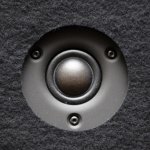
Someone mentioned Totem -
🙄
I did not suggest that anyone build a bad sounding speaker. I did (kinda) suggest that the builder put appearance before diffraction. IMO the returns are better.
You might have gathered that I tend to agree with you... I don't know how much better a purely sound quality oriented design would sound, but I know that I personally get more joy from a significant appearance improvement than an arguably marginal sound quality improvement. And I'll see the speaker day in and day out, while I may not listen actively enough to appreciate the sound improvement more than a few times a week. But maybe that's just me...
And just to prove my point (or mock myself) I'm attaching some "prettier" renderings 😉
Attachments
Last edited:
I don't think not experiencing listener fatigue has anything to do with how much you love music. My life revolves around music, but a harsh noise still troubles me and I prefer to do without it.
You're both right. There are many people out there who are not obsessed with the precision or accuracy of the sound. Most people prefer 'good' sound, but what 'good' sound is to the individual is different. I even suspect that some people like 'harsh'.
Your ability or my ability to hear past a harshness is not a good reason for someone else to design a speaker with it.
I don't think that he was saying that you should intentionally design a speaker 'with it', simply that, in his opinion, it's not as big a deal as everyone seems to think it is.
And in some ways, I agree with him. You are never going to get rid of baffle diffraction (without an infinite baffle, obviously). Yes, you can take measures to tame some of it but the moment that you mount more than a single driver, you're going to get a baffle that's going to diffract.
I also agree with John in that people are going to praise you for how 'pretty' your speakers are rather than how they sound (which was his point) and that is an important consideration to many. I am always skeptical of the person that says that they don't care about the aesthetics of their setup; more often than not, I'm pretty sure that they're lying... either to themselves or to me.
But ultimately, some will choose a speaker that looks 10% better than a speaker that sounds 1% better (not that you can quantify such things). It's up to the OP.
All those little measurable differences really add up in the end. Certainly not earth shattering, but readily noticeable.
Of course they do, and there are hundreds (thousands?) of variables to consider when engineering your perfect sounding speaker (and, more importantly, your listening environment, like where your furniture is, etc).
When I first came to this site, everyone told me that speaker design is about compromise. Choosing those things that are most important to you. Now that I've done a lot more reading, I see that. The OP was simply asking about the ED of cylindrical enclosures. How did we get here?
Disclaimer: I'm no audio expert or professional and I could be talking complete rubbish... but then again, so could you.
Back to the speaker design in question....
Your top edge is still square and is going to diffract for all three of your drivers. Whether that will be a remarkable problem, I don't know.
- Status
- Not open for further replies.
- Home
- Loudspeakers
- Multi-Way
- Elliptical enclosure - reflection/diffraction issues?
